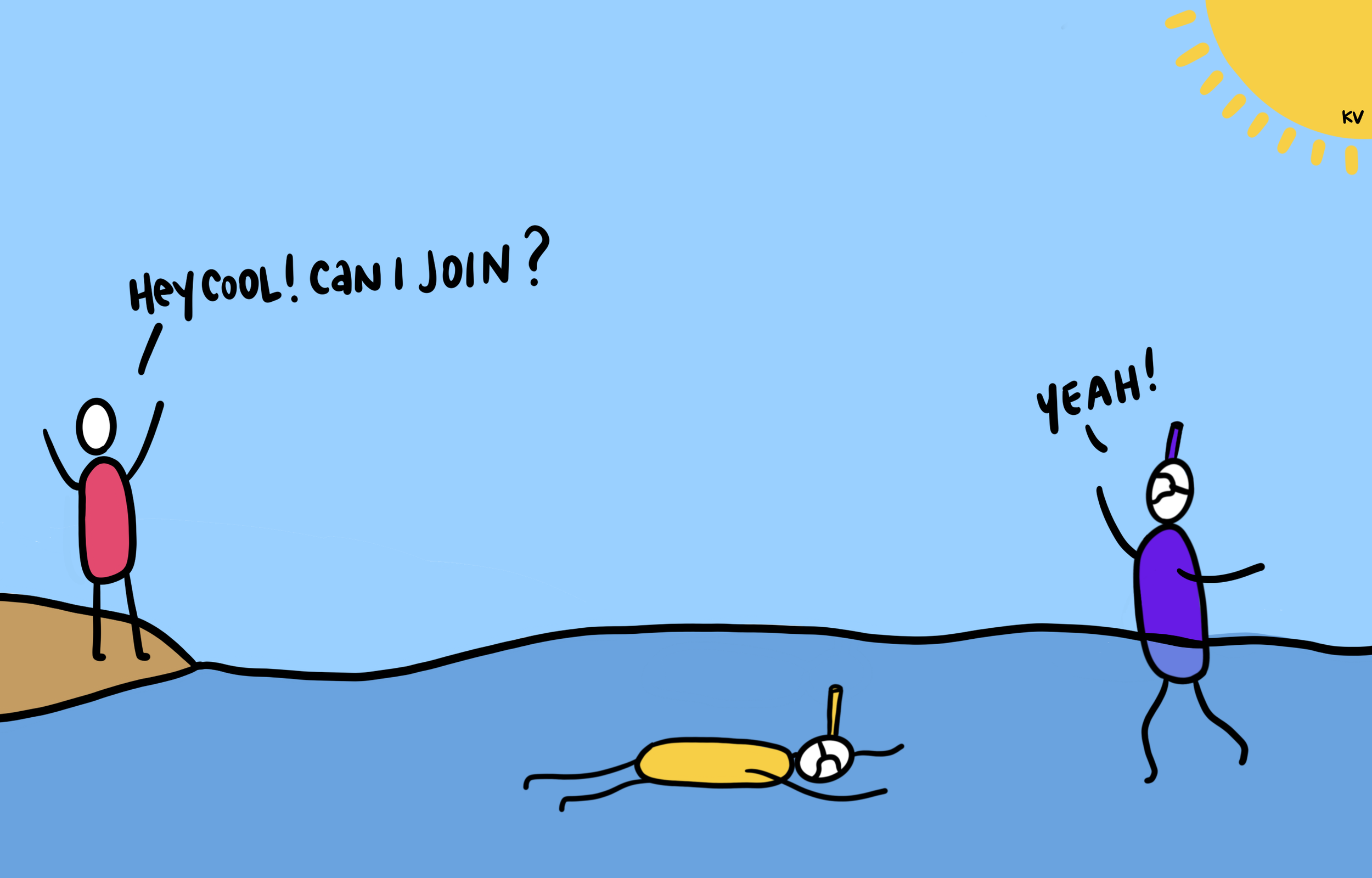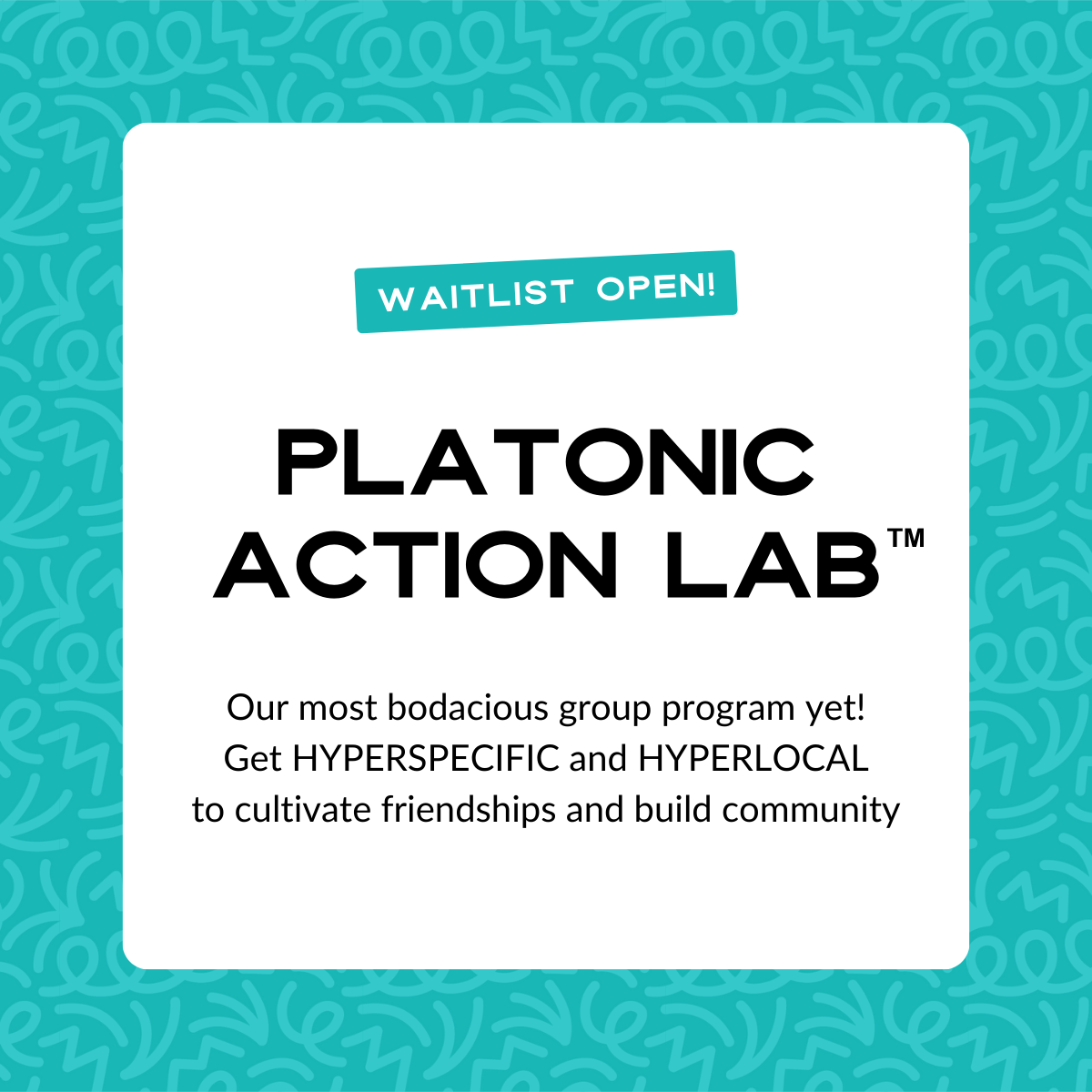The newcomer’s shortcut to deeper connection
Once upon a time, I spent a year living in an intentional community called Kalani, nestled in the tropical coastal jungle on the southeast coast of the the big island of Hawaii. I was on sabbatical, living together with 125+ other residential volunteers at a wellness and education retreat center. Most of the residential volunteers stayed for 1-3 months, though some stayed for far longer — one guy had been there for other 20 years. My year at Kalani was one of the best experiences of my life. It was also a setting where I learned A LOT about group dynamics, and where I happily contributed my skills as a facilitator and program coordinator. Today I’d like to share with you one of the lessons from my time there, that’s applicable to any gathering or group, no matter where you are. Today’s lesson is even useful in the simplest setting: a small group conversation.
🌴 Picture this: Palm trees swaying gently in the breeze, the warm sun on your skin, and the wind is blowing sweet air and sweet people into and out of your life. Every single week at Kalani, some people departed and new people arrived, each person’s varying length of stay overlapping with others like tangles of seaweed.
When you’re in a setting where people are constantly joining and leaving at unpredictable intervals, two things will happen:
😍 On the plus side:
The ever-changing flow of people will make the place feel fresh, energetic, and vibrant. There will always be new people to talk to, and the curiosity and openness carried by the newcomers can feel endlessly refreshing. Each new person is like the dawn of a new day.
😭 And on the down side:
In this ever-changing setting, it can be challenging to develop closeness and depth with others, because the people you’re trying to get close to might leave any week. And even while they’re still around, your closening process will be frequently interrupted, resetting at a less-deep level when new people join. (closening: to make close; intransitive verb: to become close or more close)
For years, I’ve seen the following images in my mind every time I think about this or see it happening in front of my eyes, say, at a party, a conference, or any conversation where people are some people are quickly arriving and departing, and some people are trying to root down and build a camp of closeness.
Beginning a new conversation or new friendship is like sitting on the proverbial shore of a beach. The waves lap at our toes, and the conversation topics stay light and shallow. We talk about the weather, how the day is going, and we make light chit chat about the things we observe in our immediate surroundings.
Then, we start to go deeper. We put on our snorkel gear and swim away from the conversational shore. This takes some courage (and a knowledge of how to swim). But our courage is rewarded, because we begin to see things in each other that are not visible from the surface. If we choose to be even braver, we might even scuba dive into deeper intimacy. This takes even more courage (and special training for real scuba.) With a stronger level of commitment and vulnerability, we discover hidden treasures buried far away from the surface inside each other and along the sea floor.
To develop a closeness in a conversation or a friendship, you have to be willing to swim away from the shore. Remember this when you’re a newcomer to any conversation, gathering, or friend group.
Join the depth that’s already in progress
Even with the best of intentions, there’s This Thing that can happen whenever a newcomer joins a conversation or group already in progress. I’ve seen it happen countless times and it secretly frustrates me every time. I call it The Shallowing. It’s when a newcomer’s arrival suddenly throws everyone back onto the shore.
Two people will have already started the process of deepening their conversation (or friendship!)... Then, a new person arrives onshore and wants to join in. Being the loveably inclusive people we are, we welcome them warmly. We swim back to shore or get washed there by a giant metaphorical wave called Reset.
Back on the shore, the people who already went deep together start over with the newcomer.
This seems totally silly when you think about it from a snorkeling perspective, but it happens all the time in conversation.
Newcomers often assume that the conversation will turn to focus on them, and it usually does. The conversation orients towards the chatty new person who just arrived. Whatever intimacy, depth, or focus the group already achieved is set aside, and intimacy is reset at a lighter level that’s appropriate for people who don’t know each other yet, or whatever the new person prefers or is comfortable with.
Now three people are on the shore. They begin getting to know each other, or to explore a conversational topic together. After a time, they feel ready to go deeper, and so they swim away from shore together, paddling into deeper emotional territory.
And then it happens … again. Another new person arrives on the shore (or pulls up a chair, or sits down at the table, or sidles up to a conversation already in progress.) Suddenly, the big wave named Reset whooshes everyone back to the shoreline again.
And this cycle continues again and again and again.
During my year at Kalani, I ate roughly 1000 communal meals in the field of picnic tables on the community’s dining lanai. I watched this dynamic play out in a type of Groundhog’s Day at breakfast, lunch, and dinner. After a while, frustration would set in for long-termers like — folks who planned to stay for months or years. We wanted to form deeper connections, but the wave kept pulling us back to shore.
As a conscientious newcomer, you have the power to prevent The Shallowing. This critical moment when you arrive is the moment where you can change the paradigm — holding onto the depth that already exists, and jumping into it with both feet.
How to solve (or prevent) this problem
The solution to this problem is not to stop being inclusive. Nor is it to turn away from newcomers with a bitter #NoNewFriends attitude. There are two solutions, and each is quite simple, once you have this dynamic in your awareness.
Solution #1: Get in the practice of extending an invitation to an intentional container of togetherness. I describe this in greater details in my TEDx Talk. (If you watch the TEDx Talk, you’ll get to see some fun pictures from my time there too). This strategy honors the fact that sometimes you just want to swim out to the conversational or relational depths. It’s ok to invite people to do that with you, even if you’re a newcomer.
Solution #2: Jump into the water as a conscientious, intimacy-minded, depth-respecting newcomer. In short: If you’re joining an existing conversation or existing group, first listen to what’s going on, and then catch up. Be a thoughtful joiner, aware of the fact that you’re hopping into a flow of closening that’s already in progress. The best way to become a part of it is to not require that everything reset around the interruption that your arrival poses.
To apply this when you’re sidling up to a conversation already in progress: Make a brief introduction and make it clear that you’re ready to participate in the conversation already in progress, not to hijack it simply because you’ve arrived.
Instead of: “Hi, I’m Kat! Nice to meet you. Did you try the fruit punch? Wow, it’s so yummy. And what a gorgeous day, isn’t it? :)”
You can say: “Hi, I’m Kat! Thanks for letting me join you. I’d love to hop into whatever conversation you’ve got going, so please continue, I’ll catch on. :)”
This is a generous and thoughtful way to both respect the conversational adventure that was already in progress before you arrived, and take a mini shortcut into closeness since you’ll get to join the intimacy snorkeling trip that’s already in process.
Q: “What if I’m accidentally joining a conversation that was really personal, and they don’t want to talk about something private in front of me?”
A: Trust me, if they really want to stop the conversation that was already in progress, they will. If they make it clear that they’re done with the previous topic and they want to start something new with you, don’t press. Just roll with it. If you need some conversation starters that don’t suck, check out my Better Conversations Kit.
I hope that today’s lesson helps you see ways that, as a newcomer, you can conscientiously help yourself and the people around you when you’re a joining any existing conversation, gathering, or friend group.
If you’ve previously felt frustrated by folks who weren’t the most welcoming to newcomers, consider that this might be the reason why. It doesn’t mean they have anything against you personally! They likely just want to hold onto the delicious depth they’ve already established and they’re afraid to lose it. If you can reassure them that you want them to keep that depth — and make it clear that you want to contribute to that too — it’ll make the transition and integration process easier for you both. I hope that's a comforting reminder for you, if you've ever felt nervous or unsure about how to get integrated into existing conversations or friend groups.
If you’re arriving on shore and have the chance to join a conversational snorkeling trip — or a “friendship scuba group” — that’s already splish-splashing away, embrace it for the gift that it is. When you're invited to join, other people are showing that they trust you, and by catching up to their existing journey, they'll feel respected and you’ll get a quicker path to deeper connection.
Swim out, catch up, and discover the hidden treasures inside each other and under the deep blue sea together.
Do you have a story or reflection to share related to this topic? Tell me about it here. This post was initially shared with subscribers of my newsletter. For practical friendship advice and invitations to events for friendship-minded people, subscribe below.
XO,
Kat Vellos, author of We Should Get Together: The Secret to Cultivating Better Friendships
© 2024 Kat Vellos. This post, like everything else on this website, is copyright of Kat Vellos. All rights reserved. No one else may use this content without permission.
Want my help making hyperlocal or hyperspecific friends?
Learn more about Platonic Action Lab






